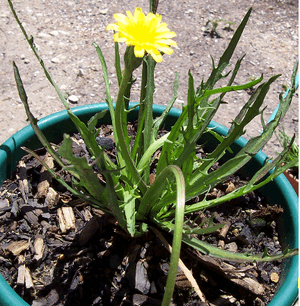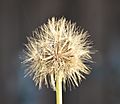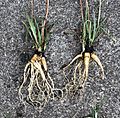Microseris scapigera facts for kids
Quick facts for kids Microseris scapigera |
|
|---|---|
 |
|
| Scientific classification | |
| Genus: |
Microseris
|
| Species: |
scapigera
|
| Synonyms | |
|
|
The Microseris scapigera is a beautiful plant with bright yellow flowers, looking much like a daisy. It's a type of perennial herb, which means it lives for more than two years and grows new stems each season. You can find this plant growing in New Zealand and Australia.
This daisy is special because it's the only Microseris species found in New Zealand. In Australia, there are two other similar species: Microseris lanceolata and Microseris walteri. All these plants belong to a larger group called Cichorieae, which also includes well-known plants like chicory and dandelion.
Sometimes, people used to call the "yam daisy" or murnong by the name M. scapigera. However, scientists now know that the true murnong is actually M. walteri. Sadly, Microseris scapigera is now quite rare and vulnerable. This is mostly because it has lost many of the places where it used to grow naturally.
Contents
Understanding the Microseris scapigera Name
Have you ever wondered how plants get their scientific names? It's a bit like a detective story!
Early Discoveries and Naming Challenges
In 1769 or 1770, explorers Joseph Banks and Daniel Solander found this plant in New Zealand. They collected samples, but Solander's notes were never officially published. Later, other scientists mentioned their findings.
One of the first to list a name was Georg Forster in 1786. He called it "Scorzonera scapigera S." but didn't describe it fully. Then, in 1839, Allan Cunningham gave a short description. He mentioned Solander's notes and samples collected by Banks and his own brother, Richard.
How Microseris scapigera Got Its Official Name
Another botanist, Joseph Dalton Hooker, thought the plant didn't quite fit into the Scorzonera group. He suggested it belonged in Microseris. In 1852, he named it Microceris Forsteri.
However, Cunningham's earlier description with the name scapigera was published first, so it had priority. Finally, in 1866, Carl Heinrich Schultz 'Bipontinus' officially combined the genus Microseris with Cunningham's specific name, creating Microseris scapigera. This is the name we use today!
Sorting Out Similar Microseris Species
For a while, some experts thought all the Australian Microseris plants were just one species, perhaps called M. lancifolia. But in 2015, a scientist named Sneddon said there were at least two separate species.
Then, in 2016, botanist Neville Walsh officially described a third species, which he named M. walteri. This helped clear up the confusion and gave each unique plant its own proper name.
Comparing Microseris Species
It can be tricky to tell the three Microseris species apart just by looking at them. Scientists like Neville Walsh have studied their features closely. Here's a simple way to see the differences:
| Feature | M. walteri | M. lanceolata | M. scapigera |
|---|---|---|---|
| Roots | Has one main fleshy root that forms a tuber (a swollen part for storing food) each year. | Has several fleshy roots that are long and thin, branching just below the ground. | Has several roots that are long and thin, usually branching close to the leaves. |
| Fruit (Capsela) | Usually shorter than 7 millimeters. | Usually shorter than 7 millimeters. | Mostly between 7 and 10 millimeters long. |
| Pappus bristles | About 10 millimeters long and 0.5–1.3 millimeters wide at the base. | 10–20 millimeters long and about 0.3–0.5 millimeters wide at the base. | Very long, between 30 and 66 millimeters. |
| Joined petals (Ligule) | Usually longer than 15 millimeters. | Usually longer than 15 millimeters. | Up to 12 millimeters long. |
| Origin | Found in lower areas of southern Western Australia, South Australia, New South Wales, ACT, Victoria, and Tasmania. | Rarely found on basalt soils; grows in high mountain areas of New South Wales, ACT, and Victoria. | Mostly found on basalt plains in western Victoria and higher places in Tasmania. |
| Taste of roots | Tastes sweet, whether eaten raw or cooked. | Tastes bitter, a bit stringy, and not very pleasant to eat. | A bit stringy and slightly bitter, but okay to eat. |
Uses of Microseris scapigera
While the famous murnong (M. walteri) was a very important food source for Indigenous Australians, Microseris scapigera also has roots that can be eaten.
Edible Roots
The roots of Microseris scapigera are fleshy and not too stringy. They have a slightly bitter taste when eaten raw, but this bitterness can be removed. If you boil the roots in water for about 5 minutes, they become much milder and ready for cooking or eating.
Indigenous Australians in southeastern Australia used to rely on the tubers of the yam daisy as a main part of their diet. They even actively grew and cared for these plants. In the Thura-Yura languages, this plant is known as ngampa.
Images for kids






